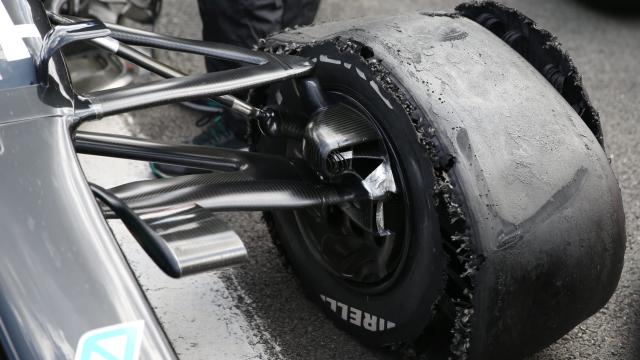Ever since Pirelli joined the Formula One circus, taking over for Bridgestone in 2011, its rubber has rubbed me the wrong way. The series removed refuelling during in-race pit stops under the guise of safety following the 2009 season, and was looking for a way to improve ‘the show’ of a Grand Prix weekend. With a new tyre supplier jumping on board, the series asked Pirelli to construct a tyre that had a high performance envelope when new and also wore out quickly.
The goal here was to offer an unpredictable element to the race, giving drivers an option to push hard on their new tyres or favour a strategy of taking the race at a reasonable pace and trying to keep the tyres functional without needing an additional pit stop. The thinking here was that there would be late-race hard charges by people on fresh tyres, and it sort of worked. We’ve seen a few of these kinds of races play out in the last decade. But was this strategy worth it?
Nowhere was Pirelli’s intentionally half-assed F1 tyre construction shown its arse more than at this weekend’s British Grand Prix. Over the course of four laps both Mercedes drivers, running a comfortable 1-2 at the time, saw their left front tyre simply wear completely through. Valtteri Bottas lost a for-sure second place and fell entirely out of the points after limping around the track and pitting for a new set of rubber. Lewis Hamilton’s tyre blew up about 1/3rd into the final lap and managed to keep his speed high enough to come home with the victory (barely) intact.
Meanwhile, McLaren’s Carlos Sainz had a similar tyre wear deflation that dropped him from fourth on the penultimate lap. Earlier in the Grand Prix, only 12 laps into the race, Alpha Tauri’s Daniil Kvyat spun into the tyre barriers at high speed after his right rear tyre exploded with no warning. Whether it was simply explanation for their failure or the actual honest truth we’ll never know, but Red Bull pitted Max Verstappen on the final lap to clamp on a new set of boots and shoot for the fastest lap of the race, saying that his left front tyre was seriously damaged ahead of the stop.
Kvyat’s crash called out a safety car on lap 13, which is the main source of the late-race tyre drama. Everyone on the grid pitted for fresh tyres at that point, some choosing hard and others choosing mediums. With just 39 laps to the finish, around 230 km, everyone should have been safe to assume the tyres would last to the end. But F1 is more concerned about manufactured drama than driver safety.
Yes, the Grand Prix was boring until the trio of late-race tyre deflations. Yes, it was exciting to see Lewis Hamilton barely squeak out a victory with three wheels on his wagon. Yes, it was dangerous as shit to have three cars on track running as fast as possible with only three tyres. All of these things can be true.
It is a testament to Hamilton’s ability that he managed to drive to the finish line with a flat tyre and not chuck his car into the wall. It is also dangerous and disgusting that on the run down Hangar Straight he pushed his three-wheeled Mercedes up to 230 km per hour to make that happen. Make a better tyre that prevents drivers from making dangerous decisions like that in the first place.
Now, I wasn’t at the track and I didn’t see the tyres, but four drivers suffering tyre failures and a fifth saying his tyres wouldn’t make it to the end, that’s just not a tenable tyre solution. I understand that drivers put more miles on the tyres than they traditionally do in a Grand Prix. I understand that Silverstone is an abnormally rough circuit on tyres. I understand that these tyres are placed under immense load. It’s irresponsible of Pirelli and F1 to conspire to make tyres that shit the bed in just 40 laps and directly contribute to a quarter of the grid suffering catostrophic failure.
Ah, but it gets worse.
“The level of wear is quite high,” Pirelli boss Mario Isola said. “Looking at the tyre from Grosjean from the first stint, it was completely worn. I had a look at some tyres from the second stint, and the level of wear is close to 100%, so we have to understand if this is the cause of the failure.
“What is clear is that when you have a tyre that is completely worn, the protection on the tread is less so if there is a small piece of debris on track, it’s easy to damage the tyre. Some chords are visible on the tyre, so that’s why I’m saying the level of wear is close to 100%.”
He added: “Each tyre has a maximum number of laps, but this depends on the car, it depends on set-up, level of energy, which is why we cannot say that the limit is the same for everybody.”
230 km of racing and the tyre is worn to the chords.
This weekend’s Grand Prix was exciting, but it instantly reminded me of the 2013 season, which saw a similar level of disregard for driver safety. Tyre explosions caused chaos at the British, Bahrain, and Malaysian Grands Prix that year. Considering that Formula One will be racing at Silverstone again this weekend, Pirelli needs to figure this shit out quick before someone gets seriously hurt.
For as much effort as F1 has put into making its races as safe as possible for the drivers and crews, it’s astonishing that it still allows these future space ships to race on a sub-par tyre. Pirelli, build a tyre that doesn’t blow up in 40 laps, and make it snappy.
